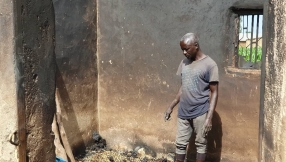The Church of England has laid claim to minerals under privately owned land covering an area the size of the Lake District, including in regions that have been earmarked for fracking, and warned landowners it owns their mineral rights, according to The Times.
Since 2010, the CofE has officially registered its ownership of 585,000 acres of underground resources, and thousands of people have received letters warning them that they do not own potentially valuable deposits under their own land.

The Times reported that in most of the cases, the Church has laid claim to deposits beneath land that it once owned, but that is now held privately.
The newspaper also said that the Church has exploited ancient property laws allowing it to claim the minerals beneath land that it owned under the feudal system, giving it the right to cash in on any profits from the extraction of stone, metals and other minerals in the earth, though it may have to compensate the surface landowners for access.
In November, the Church's investment bodies produced a report which concluded that there was no Christian reason to object to the extraction of underground resources, as long as the environment and local communities were protected. And earlier last year the CofE said that hydraulic fracturing – or 'fracking' – to remove shale gas 'could be morally acceptable'.
The Church cannot profit directly from fracking because shale gas, like oil, is owned by the Crown. But lawyers have said that it could seek compensation from fracking companies that want to drill through its minerals.
The Church told The Times that it had no plans to profit from fracking.
Land Registry data analysed by the newspaper show that the Church Commissioners, who handle almost £8 billion of assets, have filed claims to 'mineral rights' in 5,773 locations since January 2010. A change to the law that came into force in 2013 stipulated that mineral rights may be lost if not logged with the Land Registry.
Sections of England and Wales were owned by 'lords of the manor' until land was enclosed in the 19th century and converted to freehold in the 1920s, after which former landowners often retained ownership of the minerals. More than 106,000 acres were reportedly claimed by the Church under these 'manorial' rights.
A property lawyer at Shoosmiths, Gavin Le Chat, told The Times: 'It's a very archaic thing. I don't think it's reasonable or fair to landowners. It can affect the saleability or mortgageability of the land.'
More than half of all mineral rights registrations since 2010 were accounted for by Church claims, with the Duchy of Lancaster and the Crown as the next most common registrants.
Last year, registrations included 'all mines, quarries, beds of stone, clay, sand and metalliferous substances, and minerals of any description in and under the land' in an area of Billingham in Co Durham.
As well as this, the rights to 'all mines and minerals' in five sites around Retford in Nottinghamshire were also included, all of which fall within 'shale prospective areas' identified by the British Geological Survey.
More than 2,000 of the CofE's sites fall within local authorities where licences have been granted for companies to explore for oil and gas.
The Times said that the Church is understood to have registered almost all the sites where it holds mineral rights.
The Church Commissioners said that they were not claiming new rights and were required to register existing rights 'so that the Land Register will show who owns the surface and, where severed, who owns the minerals interest', adding: 'Our mineral rights registrations have no relation to fracking. There are absolutely no plans for us to exploit our land or mineral rights for that purpose.'













